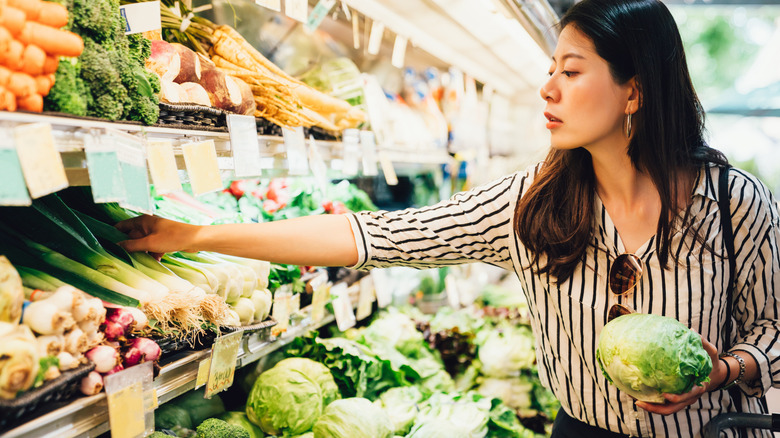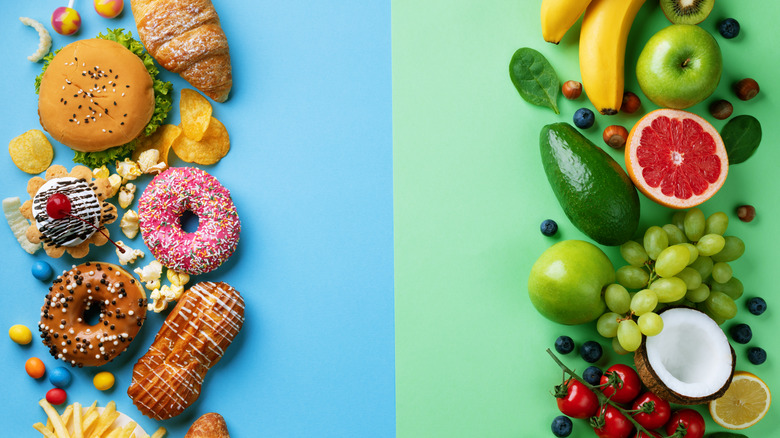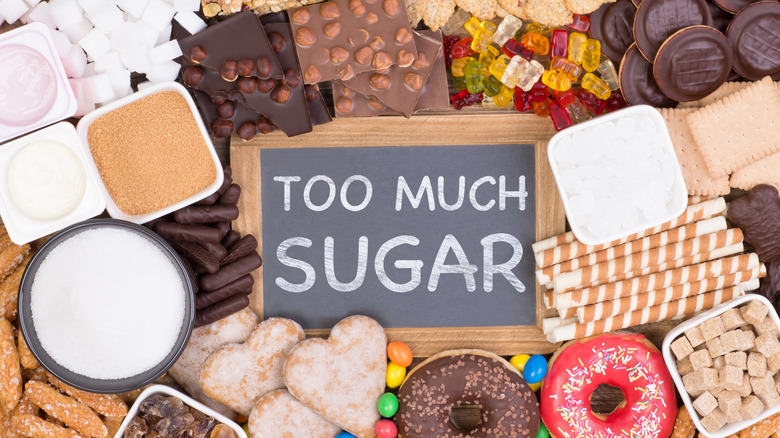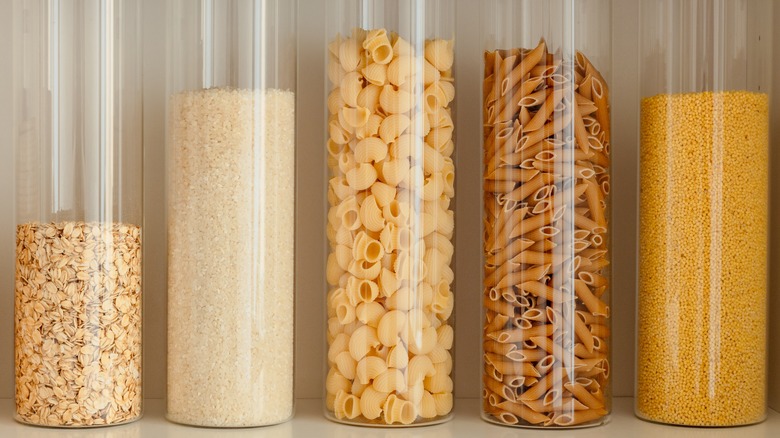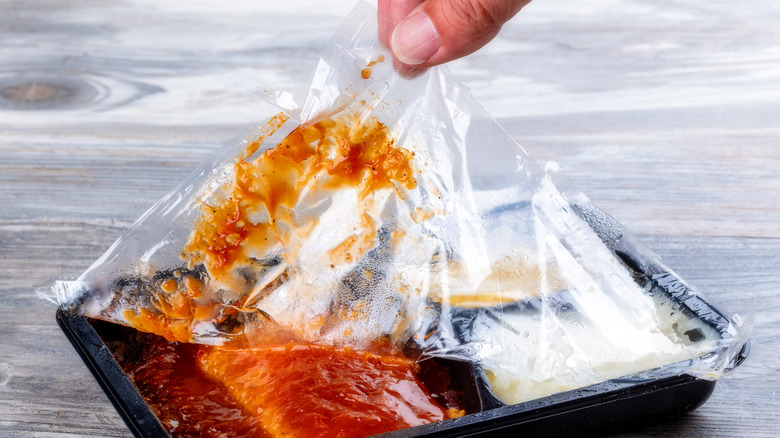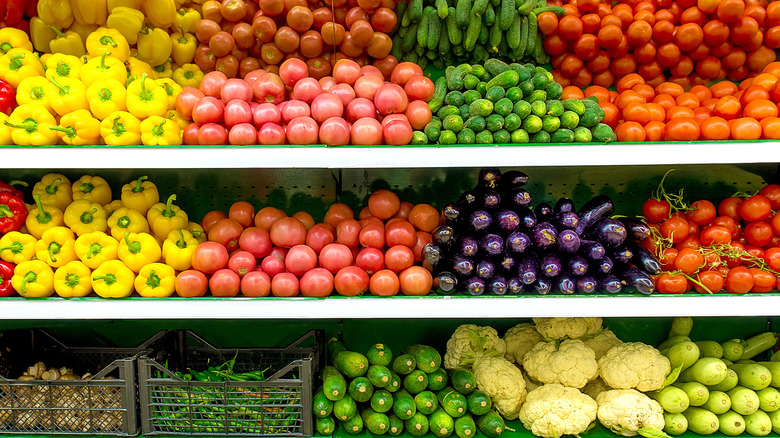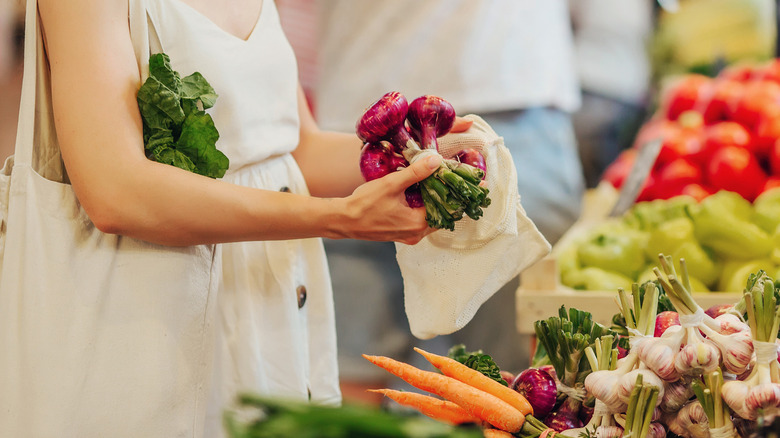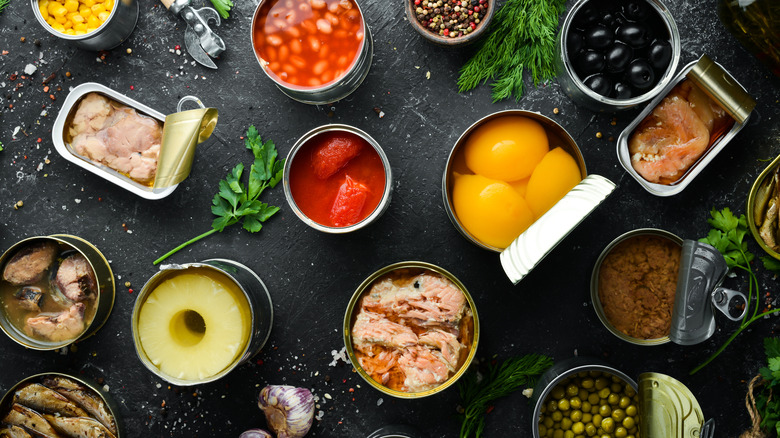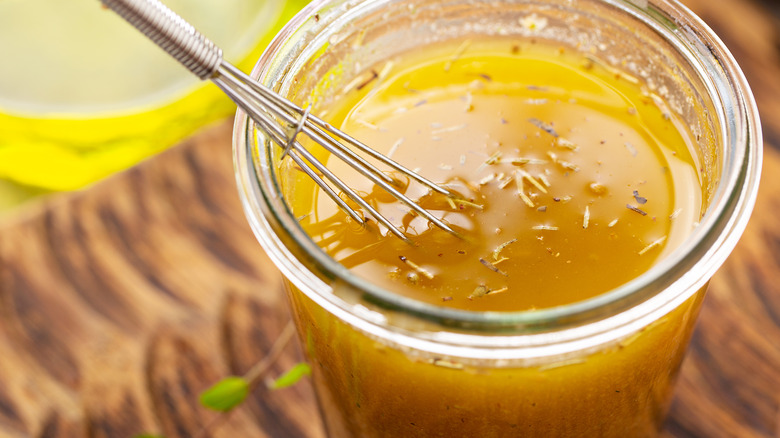Your Ultimate Guide To Healthy Grocery Shopping
It stands to reason that your diet can only be as healthy as what you put into your grocery cart, so making sure you have a healthy, well-balanced collection of items on your grocery list is the best place to start. You're probably used to hearing the fact that Americans are not eating enough fruits and vegetables, but nonetheless, it's a tidbit that's probably worth repeating. The CDC reports that only 9% of American adults are eating enough vegetables, and only 12% are eating enough fruit. Both fruits and veggies are a part of a well-balanced diet, and can help stave off heart disease, diabetes, some cancers, and obesity.
In addition to piling fruits and veggies into your carts, there are other grocery staples you're going to need to toss in for your ideal diet, including whole grains and healthy protein (via the Harvard T.H. Chan School of Health). While grocery shopping may seem straightforward, there are actually some hacks you can use to streamline your shopping and make sure you get the most out of your experience. If this is your first foray into healthy grocery shopping, continue reading to learn a few tips and tricks to help you stay on track.
Create a meal plan
Having a meal plan is an excellent way to organize your healthy eating, and can assist you in staying committed to your dieting goals throughout the week. According to Healthline, meal planning is also a great way to save money. Start small, so as not to not overwhelm yourself and to build confidence over time. For example, experts suggest planning just a few meals and or snacks for the week ahead, and adding in more as time goes on.
Next, the site suggests making sure you are incorporating all the food groups into your plan — that means fruits, veggies, legumes, protein, whole grains, and plenty of healthy fats. As you are building out your plan, be sure to keep these food groups in mind for your grocery list.
Organizing your kitchen pantry to make sure that you have enough space for all the goods you'll be bringing home is another important step. You may even want to invest in new tupperware, so that you can store premade meals or leftovers more easily. Experts at the site say that glass is ideal because it is eco-friendly and can be microwaved safely, so be sure to add it to your list.
Don't go without a list
If you've ever had the experience of running into the grocery store — fully intending to buy a healthy assortment of goods — and instead leave with several boxes of frozen pizza, pie, and soda, you may need to take down a few notes on this one.
After you've successfully completed your meal planning for the week, the next step is going to be jotting down all of the ingredients on your grocery list. In order to make the process more streamlined, experts at Healthline suggest breaking down your grocery list into sections to stay organized, and potentially make your trip faster. Make sure that your list is well rounded, and that it includes a mixture of "whole, nutrient dense foods." According to the site, suggested categories for your shopping list may include fruit, starchy vegetables, non-starchy vegetables, beans and grains, nuts and seeds, dairy/non-dairy substitutes, condiments, drinks, and miscellaneous. If that sounds intimidating, it's unlikely that you'll have to re-purchase some of the "shelf stable" ingredients such as peanut butter, oil, and bulk grains each time you go to the grocery store.
If you get the urge to revisit some old unhealthy classics, merely looking at your grocery list should help you get back on track.
Become a nutrition label expert
A major part of healthy eating is knowing exactly what you're putting into your body. Nutrition labels are helpful in the sense that they outline recommended serving sizes, nutrients, and ingredients, but can be difficult to understand if you don't have the proper training.
Luckily, the FDA has developed a system to make it easier. The first thing you'll see at the top of any label is the serving size, which lets you know how many servings are in the package, and the actual size of the serving (one cup, for example). This will be your reference point for all other information you see on the package, including calorie count, sugar, fat, etc. This makes it easier for you to control portion sizes and to better compare your choices.
Beneath the serving size you'll find the calorie count, which shows how many calories you are eating per serving. Calories refer to the amount of energy you're getting from your meal. Beneath that, you'll find all the nutrients broken down in the food, letting you know where the calories are coming from. The FDA suggests trying to find foods with less saturated fat, added sugar, and sodium, so be sure to look out for that on your label. You can also choose foods based on certain things you do want in your diet, such as more protein, calcium, or iron. To get a full breakdown on how to read the label, be sure to check out their guidelines.
Avoid processed food
Processed foods are on pretty much every nutritionist's black list for a reason. However, scientists have developed a new term to refer to certain foods in this category that may make them even less of a desirable treat.
According to a 2019 study published in Public Health Nutrition, the term "ultra-processed" refers to types of food that contain ingredients "never or rarely used in kitchens," which may include high fructose corn syrup, hydrogenated oils, and additives "designed to make the final product palatable or more appealing." Those additives may come in the form of flavor enhancers, colors, thickening agents, or glazing agents. The report states that foods in this category may include industrially produced packaged bread, soda, margarine, cookies, and cakes.
Dietitian Molly Hembree spoke to Eat This, Not That! and explained, "One way to think of food processing is how many steps have to be taken from the farm into the form you are eating on your plate." She goes on to mention that it is common that some level of processing (like puréeing pumpkin or freezing strawberries) may be necessary to get you the final product, but that further manipulation may take away some nutritional value.
Avoid added sugar
Added sugar is another "sneaky" ingredient to look out for on ingredient labels, and may be present in more foods than you think.
Harvard Health Publishing explains that while the obvious offenders such as sugary drinks and candies are important to avoid in excess, added sugars can also be found in seemingly innocent products such as crackers, salad dressing, and pasta sauce. As Debbie Krivitsky, a registered dietitian at Harvard-affiliated Massachusetts General Hospital, explains, "It's the added sugar that's problematic. Not the natural sugar in fruit, which has fiber to slow absorption, but added sugar—such as honey, molasses, and corn syrup." As you look at the nutrition label, experts at the site say to look out for ingredients that end in "ose," such as dextrose, fructose, and maltose, as well as for syrups and juices.
Added sugar can contribute to weight gain, heart disease, diabetes, and a number of other health concerns. Because they are immediately digested, they can cause a spike in your blood sugar. According to Dr. David M. Nathan, a Harvard Medical School professor and the director of the Diabetes Center and Clinical Research Center at Massachusetts General Hospital, "That challenges your pancreas to pump out more insulin. If the pancreas can't keep up with that demand, blood sugar levels rise, which can lead to more problems with insulin secretion, and ultimately to diabetes."
Stock up on pantry staples
Having a solid pantry filled with healthy ingredients can help you pull together meals quickly and in a pinch. Furthermore, making sure you have certain healthy ingredients on hand can prevent you from being tempted to eat out and make unhealthy choices.
Experts at Healthline agree, and say that stocking your pantry, freezer, and fridge with nutrient dense staples is a must. In their list of pantry staples, the site starts out by recommending canned and dried beans and lentils, saying that they are some of the "healthiest foods you can eat." Both beans and lentils have a long shelf life, which means they'll last in your pantry for a super long time — up to 10 years, in some cases.
"Nuts, seeds, and their butters," are next up on their list for being highly nutritious, and also having a pretty good shelf life of about one to four months. Grains such as brown rice, quinoa, spelt, and oats also have a shelf life of several years, and can be used to create highly nutritious bowls. Healthy fats like coconut oil, olive oil, and ghee also made the list, as they also have a long shelf life and can contribute to your overall health.
Avoid frozen meals
While it may be tempting to pick up a few frozen meals at your next trip to the grocery store due to time constraints, ease, or perhaps just familiarity, experts caution against it.
The simple act of freezing food and eating it may not be harmful to your health, but it's the hidden ingredients in frozen meals that may be causing the harm. According to the CDC, Americans generally derive over 70% of their sodium intake from processed and packaged foods, such as the kind you buy in the frozen section of the grocery store. Excess sodium can contribute to high blood pressure, and make you vulnerable to heart attack and stroke down the line.
There's also the potential for clogged arteries, as many frozen meals may be using what are called partially hydrogenated oils in their preparation (via Chron). The American Heart Association explains that these oils are the major contributor of trans fat in our diets, which have been linked to high cholesterol levels, and thus an increased risk of heart attack and stroke.
Furthermore, if you are using frozen meals such as Lean Cuisine in an attempt at cutting calories, experts at Eat This, Not That! explain that these meals contain far too few calories than are recommended per meal, which can lead to muscle deterioration and potentially overeating down the line.
Head to the bakery for bread
Heading to the bakery to buy yourself a loaf of bread may seem a little old-fashioned, but research says it's actually the best bet for your health.
While many people may still be leery of eating bread due to a wealth of low-carb bad publicity over the years, whole grain bread can actually be a healthy part of a balanced diet. In terms of where to get this bread, Jonathan Davis, senior vice president of research and development at La Brea Bakery, states via Cooking Light that he "would encourage people to skip the bread aisle and look for a freshly baked loaf within the in-store bakery."
According to Medical News Today, because packaged bread needs to have a longer shelf life due to processing times, it contains a mixture of preservatives and added sugars that are no good for your health. So how do you avoid these ingredients? You guessed it: Look at the nutritional label. "Taking a look at the ingredients is something all consumers should do before buying bread. Ingredients give consumers insight into how the bread will taste, so it's important to know more about how the bread was made," Davis says.
Try out these healthy grocery stores
If you've tried everything and you're still having a hard time making good choices at the grocery store, why not do yourself a favor and just head straight to a healthy one?
It might seem odd, but nutritionists agree that there are grocery stores that are healthier than others — and that can make the process of eating healthy easier for you. As New York-based culinary nutrition expert and author of "52-Week Meal Planner" Jessica Levinson, RDN, CDN explains to Women's Health, "Walking into a supermarket with beautiful, fresh, vibrantly colored produce is the most inspiring way to encourage healthy eating and increased consumption of fruits and veggies." As a rule, Levinson recommends shopping at supermarkets that have a wide array of fruits and vegetables, fresh meat, fish, whole grains, and an assortment of other healthy staples. She also mentions leaning toward stores that have an organic section, or even "in store dietitians."
Experts at the site selected a variety of grocery stores, starting out with Trader Joe's for its low prices, as well as its conveniently packaged produce items that make it quick and easy to prepare healthy food. Another favorite is Sprouts, which has more of a farmer's market feel, with an expansive produce section with seasonal offerings.
Shop the rainbow
"Shopping the rainbow" is a clever way to describe making sure your diet is chock full of foods that are good for you. And no, in case you were wondering, this doesn't mean heading straight to the candy aisle to pick up a pack of Skittles.
According to Healthline, this term dubbed by nutritional experts essentially means selecting an assortment of colorful fruits and vegetables every day. The reason this is advised is because fruits and vegetables contain what are called phytonutrients, which are what give them their vibrant colors. Depending on the color of the fruit, they may contain higher levels of certain nutrients which can be beneficial for your health. In general, it's good to eat any kind of fruit or vegetable. However, widening your range of colors is a good way to ensure you are getting a good mix of nutrients.
Starting with the color red, Healthline explains that these fruits and veggies are typically anti-inflammatory, provide antioxidants, and can even help prevent skin damage caused by the sun. Yellow and orange produce also has anti-inflammatory and antioxidant properties, and can also support eye health, as well as help reduce the risk of heart disease and cancer. Blue and purple help contribute to brain health, can prevent neurological disorders, and may help prevent type 2 diabetes.
Avoid distractions at the grocery store
If you've ever set foot in a grocery store (and we're guessing you have), you know how hard it can be to stay focused on your list, with so many delicious and tempting treats at every turn. According to one expert at Spark People, there is one somewhat devious reason for this: "strategic product placements" designed by supermarket chains with the intention of getting you to spend more money. Supermarkets reportedly shell out thousands of dollars on market research in order to know how people shop to develop strategies that get you to "linger longer" in the store — and ultimately, overshop.
One of the tactics they use is what the site called "end cap enticement." If you've ever wandered past the end of an aisle and knocked a few boxes of sugary cereal into your cart, we're sorry to say you may have fallen for this one. These end caps usually contain sale items, or seasonal items that are low in nutrients. The advice here? Breeze right on past, and head for the aisle like a pro.
Another supermarket trick is placing unhealthy and attractive food at eye level, which makes it easier for you to grab quickly. Instead of grabbing the first thing you see, scan both up and down the column to make sure you're getting the healthiest option.
Try eating seasonally
Eating seasonally is a great hack for healthy eating. This is because your focus here is going to be on consuming produce that is in season, as well as a healthy assortment of meat and fish when it's in season, too.
According to experts at WebMD, eating seasonally is good for both you and the environment. As a rule of thumb, it's common for fruits and veggies that are in season to contain more flavor and nutrients than those that are produced out of season. This is because when the demand for certain fruits and veggies is high all year, growers are forced to use production habits that increase the plant's resistance to certain diseases, but may actually lower their nutritional value.
Another way seasonal eating is better for your health is that it encourages you to incorporate a wider variety of fruits and vegetables into your diet, so you have a wider amount of nutrients. Additionally, buying produce that is in season "allows the environment to cycle through its natural resources and seasons," which is ultimately better for the earth.
Don't be afraid of canned food
While some canned food may not get your nutritionist's stamp of approval, there are others that can actually contribute to your healthy eating goals.
According to experts at Healthline, canned foods can be a healthy and quick way to bulk up your meals with nutrients. Furthermore, canned goods can be inexpensive, plus they have a long shelf life. Some expert-approved canned foods to include in your diet include canned beans such as garbanzos, black beans, and kidney beans, which are abundant in protein and fiber, while having low fat content. Toss them into soups, salads, and salsas for an extra boost of fiber and nutrition. Diced tomatoes are another canned good with high nutritional value that you shouldn't be afraid to use. One of the primary nutritional benefits of canned tomatoes are their high levels of lycopene, a powerful carotenoid antioxidant that is known to help prevent numerous diseases.
Olives are another healthy staple that can be found in the canned goods aisle, and they're certainly worth adding to your diet. Olives, which can form part of the Mediterranean diet, are filled with iron, calcium, and vitamin E. Just make sure to look for low sodium varieties.
Don't be afraid to DIY
A little creativity in the kitchen can go a long way when it comes to your health. While pre-prepared salad dressings and snacks can be healthy and convenient in a pinch, why not experiment with making your own?
When it comes to salad dressing in particular, the experts at Eat This, Not That! say that a good number of those that you'll find lining the shelves contain a long list of unrecognizable ingredients — often containing unhealthy fats and added sugar — that are best to be avoided. By making your own, you are controlling what goes into your dressing, and can add extra healthy components to give it even more of a nutritional boost.
If you're a fan of sweet dressings, try preparing a honey mustard dressing from scratch using dijon mustard, heart-healthy olive oil, Greek yogurt, lemon, honey, salt, and pepper. You can also whip up a dressing using fresh herbs, Greek yogurt, garlic, salt, and pepper if you prefer a more savory, herbal taste.
Lastly, Italian dressing is another salad dressing that is often loaded with added sugars. However, you can use olive oil, red wine vinegar, mustard, and Italian seasonings to create a healthy, sugar-free option.

